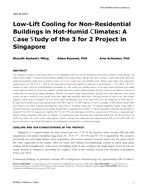Description
The dependence of countries in hot-humid climates on air-conditioning systems has been the backdrop of several research studies on energy efficiency and indoor thermal comfort. A majority of non-residential buildings in the tropics operate ‘high-lift’ and ‘all-air’ systems i.e. water-cooled chiller plants that supply low-temperature chilled water to terminal cooling coils to meet coupled space and ventilation loads. Despite typical indoor room temperatures ranging between 24 – 26°C (75.2 – 78.8 °F), the temperature of chilled water supplied to cooling coils is usually between 7 – 9 °C (44.6 – 48.2 °F), primarily in order to drive the de-humidification of ventilation air. Only recently have building engineers in the tropics started implementing de-coupled systems: dedicated outdoor air systems for ventilation and high-temperature radiant cooling technologies for space cooling for the purposes of lowerin net cooling loads and reducing fan energy consumption. However, the complete energy saving potential, especially that of high-temperature space cooling systems, can only be realized by using ‘low-lift’ chillers that supply high-temperature chilled water. This paper presents the results of the ‘3for2 Beyond Efficiency’ research project in Singapore, one of the lowest energy consuming office spaces in the tropics with a total base cooling load of 70 W/sqm (6.5 W/sqft) and an overall annual energy efficiency index of 80 kWh/sqm/yr (7.4 kWh/sqft/yr). In 2016, a prototype 20 kW modular low-lift chiller was installed at the project to provide high-temperature chilled water to its radiant cooling units. An empirical perofrmnace analysis of this chiller is presented in the paper and concludes that the modular low-lift chiller is consistently able to achieve a COP of 8 and higher in operation. By operating at a low-lift (21 °C, 69.8 °F) compared to a high-lift (28.5 °C, 83.3 °F), the improvement in COP was measured to be 29% above a comparable high-efficiency, though conventional chiller plant in Singapore. The optimization of flow and return water temperature would reduce the lift and increase the COP of the chiller. The overall sensible cooling efficiency (inclusive of pumps and cooling tower fans) improved from 0.199 to 0.163 kWe/kW. The project marks the first time that low-lift cooling has been implemented and reported in a non-laboratory setting.
Citation: 2018 Annual Conference, Houston, TX, Conference Papers
Product Details
- Published:
- 2018
- Number of Pages:
- 9
- Units of Measure:
- Dual
- File Size:
- 1 file , 1.5 MB
- Product Code(s):
- D-HO-18-C017




